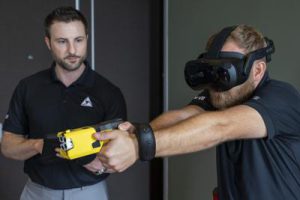
A scenario that plays out frequently for police officers across the U.S., is where the combative suspect is wearing a thick jacket which means that a taser may not be able to knock him to the ground. This scenario came into play recently in the police shooting death of one Patrick Lyoya who was shot in the head by a Michigan police officer after the taser failed to work twice on Lyoya.
Axon, the company best known for developing the Taser, is running a virtual reality training program with the aim of increasing training for police officers in simulated real-time scenarios. Another aim is to make them comfortable with split second decisions like deciding where to fire the prongs to incapacitate a suspect without needing to use deadly force.
Axon has become one of the largest suppliers of tasers and body cameras for police agencies in the U.S., as well as supplies departments and stores. The new training beginning officially on Tuesday also includes responding to domestic violence calls and calls with people with autism.
The VR training uses headsets, wrist controllers, and an actual taser with a special VR cartridge, and is all assembled in a small duffel bag. It gives police departments the opportunity to conduct the training at the police station between calls and at any time.
‘The level of repetition and really kind of training for things that are more realistic, that they don’t necessarily have time or resources for, it just enables them to do that in a much better way, a more immersive way,’ said Chris Chin, the Vice President of Immersive Technologies at Axon.
The portable setup and constant access seems to be the favourite feature for departments which have been piloting the program. Training simulators have often proven costly and requires displays being built. With Axon’s new program, the officer in training only requires a little space around them. The program can also be operated remotely, with the trainer at another location.
The training program offers the officers the opportunity to train at a virtual firing range, as well as a three-dimensional room where multiple suspects approach. The aim is to help officers quickly identify when and how to fire their weapon, including whether to use a closer or wider spread for the prongs carrying the electrical current to incapacitate.
Axon has already started expanding and creating another scenario which incorporates the taser training in a domestic abuse call.
‘We want to actually have something that’s very fluidly deployable, mobile, and can be kind of thrown in the back of a vehicle, can be done before roll call or after roll call,’ Chin said. ‘It can be done in a way where you can actually have trainers and trainees in different locations.’
In New Castle, Delaware, almost every police officer has gone through Axon’s training program.
According to Master Corporal Michel Eckerd, the virtual reality simulations now mean about 350 officers in the force can train in every shift, including overnight.
‘We’re always doing new and innovative things,’ said Eckerd. ‘The big thing with this is the convenience and the portability.’
Axon already offers police officers virtual reality community engagement training developed with the aid of community advocates, mental health experts and other experts. The program is designed to put help officers in lifelike scenarios to de-escalate a situation and handle suspects or victims.
Axon partnered with Phoenix Police Department to train officers through nine training modules. A report from the National League of Cities discovered that over 80% of officers who went through the training said it prepared them to adapt their approach to a related call. Nearly 60% of them said the training helped them to see a situation from a different perspective.
‘The virtual reality training gives the officer a chance to experience an incident from multiple perspectives,’ said Kate Gallego, Phoenix Mayor in an interview. ‘So an officer could go to a domestic violence call from the perspective of an officer and then have a chance to go to the same incident from the perspective of a victim.’
Gallego also made note of the portability feature as a major benefit in a city like Phoenix where a trip to the police academy is nearly an hour’s ride.
‘The more we can have tools that are nimble and allow us flexible training, the less time we take officers off the streets and the more we can get real results,’ she said.
By Marvellous Iwendi.
Source: AP News